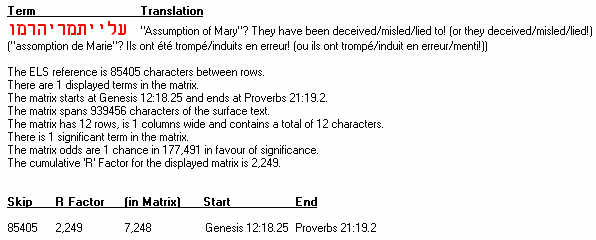
Code by Fab
Assumption of Mary? They have been deceived!
![]()

A code found in the Tanach using a wrapped text and inspired by a discussion about the Catholic dogma of the "assumption of Mary". 16 occurrences were expected and 16 were found. Only one was extendable to "assumption of Mary? They were deceived (or they deceived)!".
http://en.wikipedia.org/wiki/Assumption_of_Mary
There is no mention of Mary's "assumption into Heaven" (defined "infallibly" by Pius XII in 1950, btw) anywhere in the NT. None of the writers of the NT mention it and Paul (who is the author of most of the NT and probably died between A.D. 63 and 67: http://en.wikipedia.org/wiki/Paul_the_Apostle#Arrest_and_death) was still alive when Mary was allegedly "raptured" (around A.D. 63: http://cantuar.blogspot.com/2007/08/historical-date-of-assumption-of-mary.html), I wonder why he never bothered to mention such a feat in his letters then.
Accoding to the Catholic Encyclopedia:
http://www.newadvent.org/cathen/02006b.htm
"...Regarding the day, year, and manner of Our Lady's death, nothing certain is known. The earliest known literary reference to the Assumption is found in the Greek work De Obitu S. Dominae. Catholic faith, however, has always derived our knowledge of the mystery from Apostolic Tradition. Epiphanius (d. 403) acknowledged that he knew nothing definite about it (Haer., lxxix, 11). The dates assigned for it vary between three and fifteen years after Christ's Ascension. Two cities claim to be the place of her departure: Jerusalem and Ephesus. Common consent favours Jerusalem, where her tomb is shown; but some argue in favour of Ephesus. The first six centuries did not know of the tomb of Mary at Jerusalem.
The belief in the corporeal assumption of Mary is founded on the apocryphal treatise De Obitu S. Dominae, bearing the name of St. John, which belongs however to the fourth or fifth century. It is also found in the book De Transitu Virginis, falsely ascribed to St. Melito of Sardis, and in a spurious letter attributed to St. Denis the Areopagite. If we consult genuine writings in the East, it is mentioned in the sermons of St. Andrew of Crete, St. John Damascene, St. Modestus of Jerusalem and others. In the West, St. Gregory of Tours (De gloria mart., I, iv) mentions it first. The sermons of St. Jerome and St. Augustine for this feast, however, are spurious. St. John of Damascus (P. G., I, 96) thus formulates the tradition of the Church of Jerusalem:
"...St. Juvenal, Bishop of Jerusalem, at the Council of Chalcedon (451), made known to the Emperor Marcian and Pulcheria, who wished to possess the body of the Mother of God, that Mary died in the presence of all the Apostles, but that her tomb, when opened, upon the request of St. Thomas, was found empty; wherefrom the Apostles concluded that the body was taken up to heaven..."
Today, the belief in the corporeal assumption of Mary is universal in the East and in the West; according to Benedict XIV (De Festis B.V.M., I, viii, 18) it is a probable opinion, which to deny were impious and blasphemous..."
So, it is not founded on the Bible.